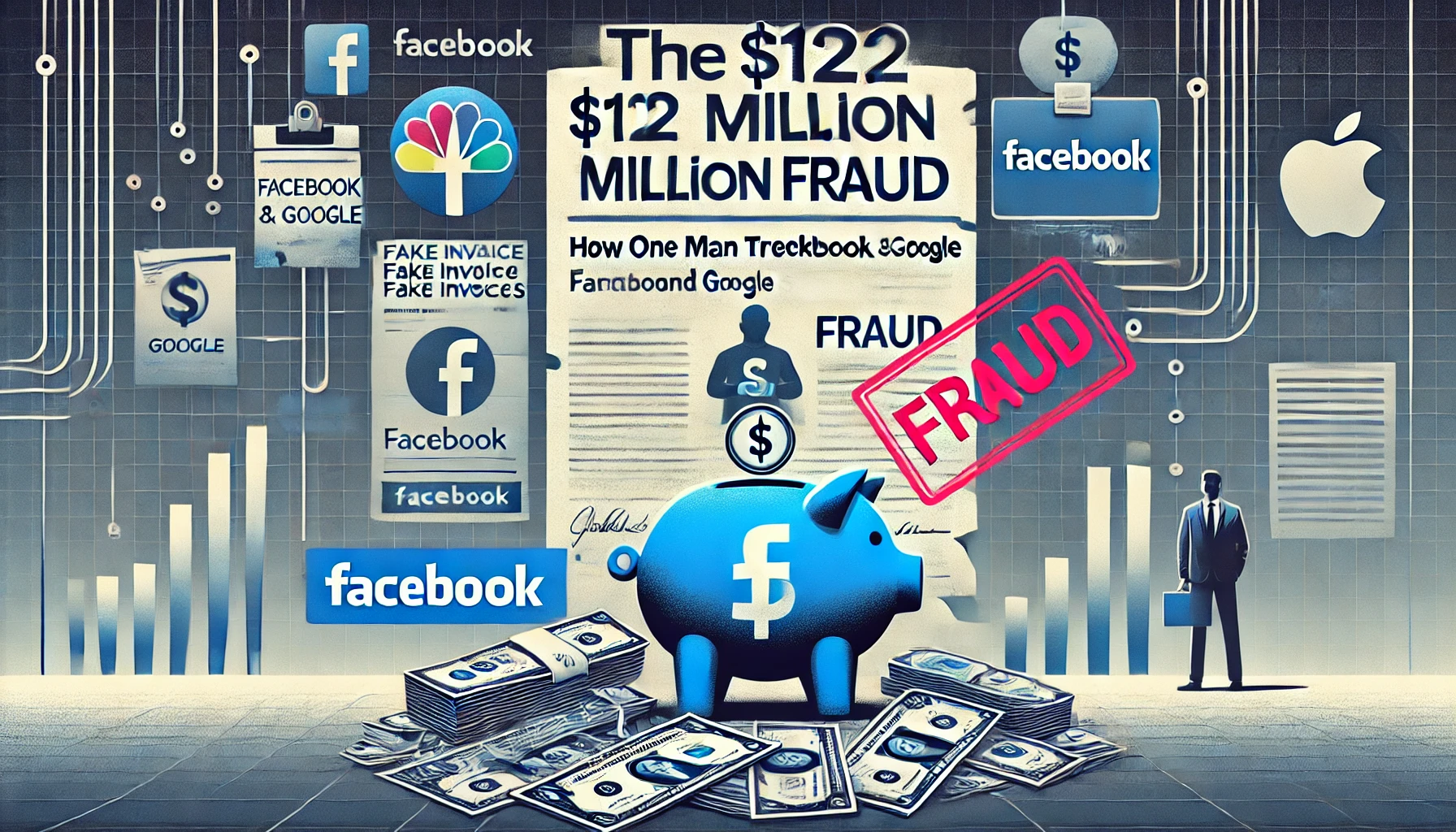Lithuanian Man Tricked Facebook and Google: The $122 Million Fraud Case
In an age where tech giants like Facebook and Google are seen as nearly invincible, the idea that these corporations could be duped by a single individual seems almost impossible. However, in one of the most audacious fraud cases in recent history, a Lithuanian man managed to steal $122 million from Facebook and Google by sending them fake invoices. This blog delves into the details of this extraordinary scam, exploring how it happened, the implications for tech companies, and what businesses can learn from this incident.
The $122 Million Fraud: A Case Study in Tech Company Vulnerability
The story of the $122 million fraud begins with Evaldas Rimasauskas, a Lithuanian citizen who orchestrated an elaborate scheme that targeted two of the world’s largest tech companies: Facebook and Google. Between 2013 and 2015, Rimasauskas sent fake invoices to these companies, claiming payments for services that were never rendered. The most astonishing aspect of this fraud is that the invoices were paid without question, resulting in a combined loss of $122 million.
Rimasauskas’ plan was surprisingly simple but executed with meticulous detail. He registered a company in Latvia with the same name as Quanta Computer Inc, a legitimate Taiwanese hardware manufacturer with which both Facebook and Google regularly conducted business. By forging documents, emails, and contracts, Rimasauskas made it appear as though the invoices were coming from the real Quanta Computer Inc.
The success of this scheme highlights a critical vulnerability in even the most sophisticated companies. Despite their vast resources and state-of-the-art security systems, both Facebook and Google fell victim to what is known as a fake invoice scam—a type of fraud that exploits trust and the complexity of modern corporate operations.
How Fake Invoice Scams Exploit Tech Companies
Fake invoice scams are a growing threat, particularly for large corporations that handle thousands of transactions daily. These scams involve the creation of fraudulent invoices that appear legitimate and are often sent to accounts payable departments without any red flags. Once the invoice is paid, the money is transferred to the fraudster’s bank account, often in a different country, making it difficult to recover the funds.
In the case of the $122 million fraud, Rimasauskas leveraged the credibility of Quanta Computer to convince Facebook and Google to pay the fake invoices. He used phishing tactics, sending emails that appeared to come from legitimate company executives, which added an extra layer of authenticity to the scam. The fraud was so well-executed that it went undetected for over two years.
The success of such scams is often due to the sheer scale and complexity of operations within tech companies. With millions of transactions being processed regularly, a single fraudulent invoice can easily slip through the cracks, especially when it is meticulously crafted to resemble legitimate business dealings.
The Role of Corporate Phishing Scams in Large-Scale Frauds
Corporate phishing scams are a significant component of large-scale frauds like the one executed by Rimasauskas. Phishing involves tricking individuals or organizations into providing sensitive information or making payments by pretending to be a trusted entity. In this case, Rimasauskas used corporate phishing to impersonate executives from Quanta Computer, thereby convincing Facebook and Google that the invoices were legitimate.
Phishing scams have become increasingly sophisticated, with attackers using advanced techniques to create emails and documents that are nearly indistinguishable from the real thing. These scams often target lower-level employees in accounts payable departments, who may not have the means to verify the authenticity of the invoices they receive.
To combat these scams, companies must invest in comprehensive cybersecurity training for all employees, particularly those in finance and accounting roles. By educating staff on how to recognize phishing attempts and other fraudulent activities, companies can significantly reduce the risk of falling victim to such schemes.
Lessons Learned: How Tech Companies Can Protect Themselves
The $122 million fraud case serves as a stark reminder that no company, regardless of its size or resources, is immune to fraud. For tech companies like Facebook and Google, the implications of this case are clear: even the most advanced security systems can be bypassed if human error or oversight is involved.
To prevent similar incidents, companies should consider implementing the following measures:
- Enhanced Verification Processes: Implement multi-step verification processes for all financial transactions, especially those involving large sums of money. This could include cross-checking invoices with purchase orders and contracts, as well as requiring approval from multiple departments before payments are made.
- Regular Audits: Conduct regular audits of financial transactions to identify any irregularities. By routinely reviewing transactions, companies can catch fraudulent activities early before they result in significant losses.
- Phishing Awareness Training: Provide comprehensive training for employees on how to identify phishing emails and other fraudulent activities. Regularly update this training to address new and emerging threats.
- Use of AI and Machine Learning: Implement AI and machine learning tools to detect unusual patterns in financial transactions. These technologies can flag potential frauds by analyzing transaction data in real-time.
- Collaboration with Law Enforcement: Establish strong relationships with law enforcement agencies to ensure prompt reporting and investigation of any fraudulent activities. This collaboration can help in the swift recovery of stolen funds and the prosecution of offenders.
The Aftermath: Legal Consequences and Recovery Efforts
Following the discovery of the fraud, both Facebook and Google took swift action to recover the stolen funds. According to reports, Google detected the fraud and promptly alerted the authorities, resulting in the recovery of most of the funds. Similarly, Facebook managed to recover a significant portion of the stolen money.
Rimasauskas was eventually arrested and extradited to the United States, where he pled guilty to wire fraud, identity theft, and money laundering. He was sentenced to 30 years in prison and agreed to forfeit approximately $50 million of the stolen funds. However, a substantial amount of the money remains unaccounted for, as Rimasauskas had hidden it in various bank accounts across Europe.
The legal consequences of this case serve as a deterrent to would-be fraudsters, demonstrating that even the most sophisticated scams will eventually be uncovered and prosecuted.
For more insights on corporate fraud and prevention strategies, visit Regent Studies.
In conclusion, the $122 million fraud case against Facebook and Google is a powerful reminder of the vulnerabilities that exist within even the largest and most advanced organizations. By understanding the mechanics of fake invoice scams and the role of corporate phishing, companies can take proactive steps to protect themselves from similar incidents. The lessons learned from this case are invaluable, offering a blueprint for how businesses can safeguard their assets in an increasingly complex digital landscape.
This blog has highlighted the critical need for enhanced verification processes, regular audits, phishing awareness training, and the integration of AI in detecting and preventing fraud. As the digital world continues to evolve, staying vigilant and informed is the best defense against the ever-present threat of corporate fraud.
By implementing these measures, companies can better protect themselves from falling victim to scams like the $122 million fraud that shook two of the biggest tech giants in the world. The story of Evaldas Rimasauskas is a cautionary tale, reminding us that in the world of business, trust must always be accompanied by verification.




